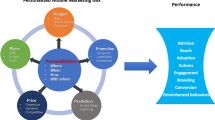Abstract
With the development of mobile commerce, situational awareness and Internet of things, the boundaries of e-commerce have been greatly expanded, and it has entered a big data era of business information. However, customers are faced with the problem that information is rich but useful information is hard to get. E-commerce is facing the challenge of how to provide personalized information recommendation services for customers and motivate customers to purchase continuously. Therefore, this paper studies the problem of e-commerce recommendation under the condition of large data, and proposes a scenario-based e-commerce recommendation algorithm based on customer interest. Firstly, according to the characteristics of customer interest such as situational sensitivity and diversity in personalized recommendation, a multi-dimensional customer interest feature vector is established by using distributed cognitive theory to differentiate the sensitive scenarios of customer interest. Then, the collaborative filtering recommendation algorithm is used to realize customer similarity judgment and product recommendation in sensitive scenarios. Experimental results show that the method has good customer interest extraction ability. Compared with other recommendation methods, it has higher recommendation accuracy and can adapt to the high-quality commodity recommendation service in the process of customer continuous purchase under complex circumstances.





Similar content being viewed by others
References
Akter, S., & Wamba, S. F. (2016). Big data analytics in E-commerce: A systematic review and agenda for future research. Electronic Markets, 26(2), 173–194.
Hamad, F., Smalov, L., & James, A. (2009). Energy-aware Security in M-Commerce and the Internet of Things. IETE Technical Review, 26(5), 357–362.
Xing, Z. (2017). The impacts of Information and Communications Technology (ICT) and E-commerce on bilateral trade flows. International Economics & Economic Policy, 15, 565–586.
Kim, M. (2017). How to promote E-Commerce Exports to China: An empirical analysis. Social Science Electronic Publishing, 39(2), 53–74.
Aaron, A., James, H., Charles, T., et al. (2016). An examination of consumer willingness to pay for local products. Agricultural & Resource Economics Review, 44(3), 253–274.
Shires, D. A., Stroumsa, D., Jaffee, K. D., et al. (2017). Primary care providers’ willingness to continue gender-affirming hormone therapy for transgender patients. Family Practice, 35, 576–581.
Chen, X., Li, Y., & Hu, T. (2015). Solving the supermarket shopping route planning problem based on genetic algorithm. In International conference on computer and information science (pp. 529–533). IEEE.
Hortacsu, A., & Joo, J. (2017). Semiparametric estimation of a CES demand system with observed and unobserved product characteristics. Statistics, 06(1), 65–80.
Bilgihan, A. (2016). Gen Y customer loyalty in online shopping: An integrated model of trust, user experience and branding. Computers in Human Behavior, 61, 103–113.
Chen, C. F., & Wang, J. P. (2016). Customer participation, value co-creation and customer loyalty—A case of airline online check-in system. Computers in Human Behavior, 62(C), 346–352.
Kashif, M., Rehman, M. A., & Pileliene, L. (2016). Customer perceived service quality and loyalty in Islamic banks. Tqm Journal, 28(1), 62–78.
Mäntymäki, M., Merikivi, J., & Islam, A. K. M. N. (2014). Young people purchasing virtual goods in virtual worlds: The role of user experience and social context. Digital Services and Information Intelligence, 445, 303–314.
Chiou, Y. C., & Liu, C. H. (2016). Advance purchase behaviors of air passengers: A continuous logit model. Transportation Research Part E Logistics & Transportation Review, 93, 474–484.
Lei, S. U. (2017). The influential factors of consumer buying behavior under the background of tribal E-commerce. Business Economy, (3), 94–97.
Bo, H., Shu, L. C., & Hsieh, S, J. (2016). Predicting and testing probability of continuous purchasing of online customers. In International conference on fuzzy systems and knowledge discovery (pp. 783–788). IEEE.
Subramaniyaswamy, V., Manogaran, G., Logesh, R., et al. (2018). An ontology-driven personalized food recommendation in IoT-based healthcare system. Journal of Supercomputing, 2, 1–33.
Bui, D. T., Tuan, T. A., Klempe, H., et al. (2016). Spatial prediction models for shallow landslide hazards: A comparative assessment of the efficacy of support vector machines, artificial neural networks, kernel logistic regression, and logistic model tree. Landslides, 13(2), 361–378.
Chakraborty, J., Thopugunta, G., & Bansal, S. (2018). Data extraction and integration for scholar recommendation system. In IEEE, International conference on semantic computing (pp. 397–402). IEEE Computer Society.
Tseng, J. C. C., Lin, B. H., Lin, Y. F., et al. (2016). An interactive healthcare system with personalized diet and exercise guideline recommendation. In Technologies and applications of artificial intelligence (pp. 525–532). IEEE.
Odić, Ante, Tkalčič, Marko, Tasič, Jurij F., et al. (2013). Predicting and detecting the relevant contextual information in a movie-recommender system. Interacting with Computers, 25(1), 74–90.
Yap, G. E., Tan, A. H., & Pang, H. H. (2007). Discovering and exploiting causal dependencies for robust mobile context-aware recommenders. IEEE Transactions on Knowledge and Data Engineering, 19(7), 977–992.
Alhamid, M. F., Rawashdeh, M., Dong, H., et al. (2017). Exploring latent preferences for context-aware personalized recommendation systems. IEEE Transactions on Human-Machine Systems, 46(4), 615–623.
Poelman, M. P., Helen, E., Elizabeth, D., et al. (2016). Package size and manufacturer-recommended serving size of sweet beverages: A cross-sectional study across four high-income countries. Public Health Nutrition, 19(6), 1008–1016.
Ramasubbu, B., Stewart, E., & Spiritoso, R. (2017). Introduction of the identification, situation, background, assessment, recommendations tool to improve the quality of information transfer during medical handover in intensive care. Journal of the Intensive Care Society, 18(1), 17–23.
Pessemier, T. D., Courtois, C., Vanhecke, K., et al. (2016). A user-centric evaluation of context-aware recommendations for a mobile news service. Multimedia Tools & Applications, 75(6), 3323–3351.
Plieninger, H., & Heck, D. W. (2018). A new model for acquiescence at the interface of psychometrics and cognitive psychology. Multivariate Behavioral Research. https://doi.org/10.1080/00273171.2018.1469966.
Chen, J., Zhang, H., He, X., et al. (2017). Attentive collaborative filtering: Multimedia recommendation with item- and component-level attention. In International ACM SIGIR conference on research and development in information retrieval (pp. 335–344). ACM.
Cui, G., Luo, J., & Wang, X. (2018). Personalized travel route recommendation using collaborative filtering based on GPS trajectories. International Journal of Digital Earth, 11(12), 1–24.
O’Mahony, M. P., & Smyth, B. (2010). A classification-based review recommender. Knowledge-Based Systems, 23(4), 323–329.
Acknowledgements
This work is supported by the College Scientific Research Project of Inner Mongolia Autonomous Region (NJZY18159), the Science and Technology Innovation Guide Project of Inner Mongolia Autonomous Region (KCBJ2018028), and the Higher Education Teaching Reform Research Project of National Civil Affairs (15085).
Author information
Authors and Affiliations
Corresponding author
Ethics declarations
Conflict of interest
On behalf of all authors, the corresponding author states that there is no conflict of interest.
Additional information
Publisher's Note
Springer Nature remains neutral with regard to jurisdictional claims in published maps and institutional affiliations.
Rights and permissions
About this article
Cite this article
Wu, Xq., Zhang, L., Tian, Sl. et al. Scenario based e-commerce recommendation algorithm based on customer interest in Internet of things environment. Electron Commer Res 21, 689–705 (2021). https://doi.org/10.1007/s10660-019-09339-6
Published:
Issue Date:
DOI: https://doi.org/10.1007/s10660-019-09339-6




